A long journey that created a masterpiece
Starting in 1390 and completing around
1580, construction of Orvieto's Duomo would be
expected to merge several styles during a time marked by
huge changes in man's view of his world, his God, and the
art that integrates both. The Duomo started out as a
Romanesque basilica, a form reminiscent of Roman public
buildings. This might seem a bit anachronistic.
Centuries before to the north, the French had raised
their great Notre Dame Gothic cathedrals in Paris and
Chartres.
Before the ceiling beams were added, the cathedral board
of works, scared that the walls would collapse once the
weight of the roof was imposed, commissioned unneeded
buttresses; these were eventually filled in to create
walls for transept chapels, superimposing a Gothic cross
footprint on the Romanesque basilica. Later as the Italian
Renaissance flourished, the right transept chapel was
decorated in a fresco masterpiece.
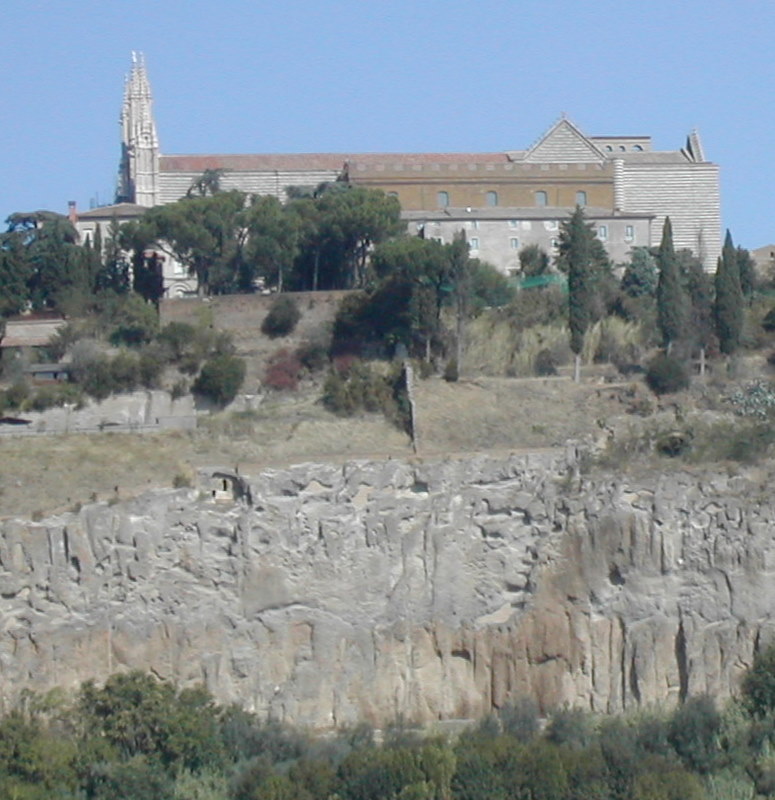 The above view
shows the tufa rock which lifts the town of Orvieto and
its masterpiece
cathedral640 feet above the junction of the
Chiana and Paglia rivers. The Duomo's
late-Gothic facade is at left. The brown building in front
was the Papal palace while the popes made Orvieto their
second home. (It's now a museum). The striped
effect on the cathedral is created by white travertine
marble layers interlaced with green-black
basalt.
The above view
shows the tufa rock which lifts the town of Orvieto and
its masterpiece
cathedral640 feet above the junction of the
Chiana and Paglia rivers. The Duomo's
late-Gothic facade is at left. The brown building in front
was the Papal palace while the popes made Orvieto their
second home. (It's now a museum). The striped
effect on the cathedral is created by white travertine
marble layers interlaced with green-black
basalt.
But we're getting ahead of ourselves. Let's turn now to
the cathedral's structure and interior.
Overall Layout
The cathedral construction was administered by a committee
appointed by the government of the city (commune).
Typically members were elected by the town council
for 6 month terms. They supervised the contracts for
the artisans and approved the purchase of materials; a
council usually consisted of a treasurer and a
representative from each of Orvieto's 4 neighborhoods.
However, artistic control was in the hands of a
capomaestro -- the
master architect. In truth, these were much more
masters than
architects. They
served as both designers and builders
[67]--
and often as sculptors, mosaicists, etc. Some were
literally hands-on managers. Typically, but not
always, they were on-site managers as well. Plans
could be quite sketchy and details would be worked
on-the-spot with the artisans in real time.
The "architecture" they practiced was not
engineering-based, but rather the accumulation of their
(and hopefully many others') experience.
Rules-of-thumb substituted for as yet
undiscovered laws of physics. Consequently, many
cathedrals collapsed over the years -- and some of them
right away. Even if the capomaestro (master
architect) got the physics right, pagan Mother Nature might
assault such godly work. Usually the cathedral was
the tallest building in town -- and therefore a lighting
rod, converting roof timbers into embers. Gravity,
lightning -- and in Umbria, earthquakes: did God really
want these stone houses of worship to soar into the skies?
Orvieto's cathedral was first laid out by
capomaestro
Arnolfo di Cambio who often supervised the
construction of several churches at one time,
[69]
making it unlikely that he would provide much detailed
daily direction to the stone masons and other
artisans. Four decades later, Giovanni di Agostino was
capomaestro at both Orvieto and Sienna at almost the same
time during 1330s; not bad for an artisan in his mid 20s.
[73]
But many of the other capomaestri at Orvieto were
clearly in residence and provided day-to-day guidance and
often hands-on involvement as seen by their handiwork in
sculpture and mosaic (and often documented in their
contracts in the Orvieto archives.) These
included Lorenzo Maitani who designed the facade,
probably did some of its mosaics, and contributed at least
two of the exterior's bronze sculptures. Another
was Andrea di Cione di Arcangelo, known as
Orcagna, who created the Rose Window.
The Capomaestro supervised all of the other artisans
who might occasionally be paid in goods such as barrels of
wine,
[85]
as happened in much other medieval construction.
A Romanesque rectangle crossed with the Gothic
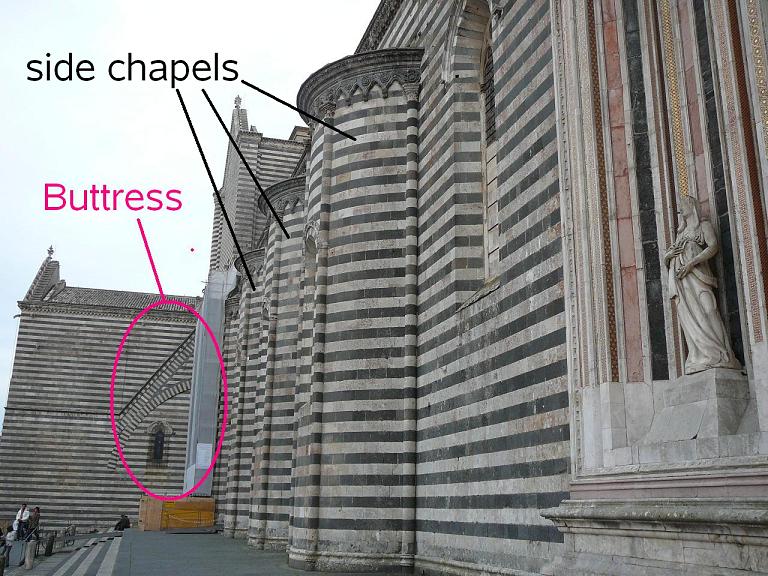
Around 1290, Papal architect Arnolfo di Cambio outlined a
basically Romanesque church and construction began.
Patterned after the rectangular basilicas that date back to
Roman days, the design evolved as time went on.
[300,301]
Since Di Cambrio was supervising construction on many
central Italian cathedrals at this time, it appears that a
local stone mason, Fra Bevignate da Perugia, exercised
day-to-day decision making in erecting the nave and two
side aisles.
[10]
As the nave neared completion nearly two decades later,
the cathedral committee became concerned about gravity.
Before the first roof timbers were put into place,
they thought that the weight of the roof would force
the side walls outward until they collapsed. (Most
likely they would have blamed this on the relatively
unskilled Fra Bevignate rather than the master architect di
Cambio whose other cathedrals stood up quite well.) To
stave off the "imminent" collapse, the committee hired a
self-described buttress expert named Lorenzo Maitani.
He created the buttresses around the sanctuary areas
which can be seen in red in the picture above. Later
engineering studies say the di Cambio's design did not need
to be saved by Maitani. (Even if it did, these
buttresses were probably too low to do much good.)
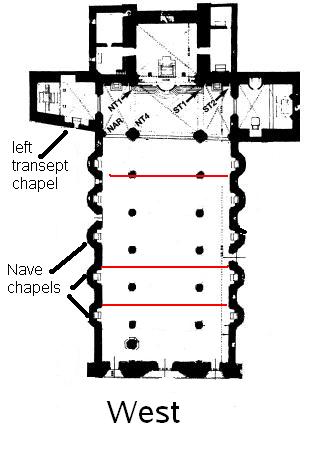
The crooked cross
Not only were the buttresses unneeded, they weren't even
straight, especially on the left (north) end as shown in
the diagram
[305] at
right labeled "left transept chapel. Probably this was
because when the east end (choir) of the nave was shored
up, another building was in the way.
Eventually Giovanni di Uguccione
[10] expanded these
buttresses into walls, converting them into transept
chapels. Thus the Romanesque basilica became a Gothic
cross-shaped cathedral (although a somewhat crooked
one).
Another modification to the basic basilica rectangle was
the addition of the half-round nave chapels. The
diagram also shows the location of the supporting piers
(marked by dots). The red lines attempt to show how these
chapels do not line up with the vaults of the naves (as
defined by the piers). Apparently this was done to give the
first floor of the exterior a consistent look as required
by Italian law.
[306]
Apparently at street level, looking good was more important
than structural symmetry, at least for buildings, if not
for people.
And why half-round chapels? Apparently because they
resembled the Pope's Lateran Palace in Rome (destroyed in
1586). When he stayed next door to Orvieto's Duomo,
the pope could look out his window and be reminded of his
Roman neighborhood.
[308]
This was a good idea in theory, but not too long after the
walls started to rise, the Papacy had a succession of
seven French popes who moved the papal court to
Avignon in southern France in 1305.
Over 80% of new cardinals during that time were
French and they, in turn, kept electing French anti-popes
after the papacy returned to Rome in 1377. Two
centuries later, the Pope returned to his palace in Orvieto
and improved the town's fortifications when the
Emperor sacked Rome in 1527.
The Interior
The Nave is generally simple and austere, but explodes
with colorful murals on the east end walls of the sanctuary
and choir.
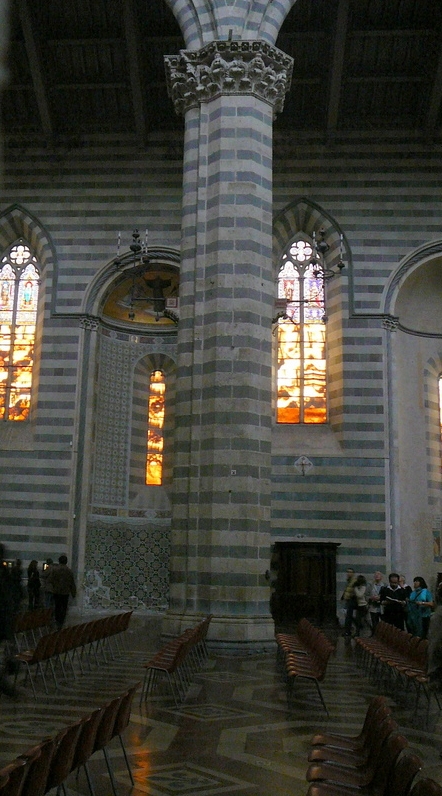
Design outside in:
Left: The 10 tall, half-cylinder nave chapels do not line
up with the spaces defined by the nave
pillars. Instead, they are positioned to make the
first floor exterior more pleasing to the Orvietans
passing by.
The shape and ornamentation of the columns, such as the
one seen at left, evolved in the two decades it took to
complete the nave. Their capitals evolve as they rose from
east to west; those last built at the west end resemble
some of the stone decoration on the facade, leading some to
speculate that the facade architect, Lorenzo Maitani, in
fact took over before the nave was finished.
[306]
The tall half-cylindrical side apsidal chapels do not line
up with the vaults rising from the pillars. Some of
these niches retain fragments from their 14th and 15th
century frescoes.
[249]
The Gothic Sanctuary
The tribune or rectangular apse is bordered on three
sides by wooden choir stalls and is frescoed on all
three sides by painters of the Orvieto School around 1370
and restored by various Renaissance masters a century
later
.[32]
Scenes depict episodes from the life of the
Virgin.
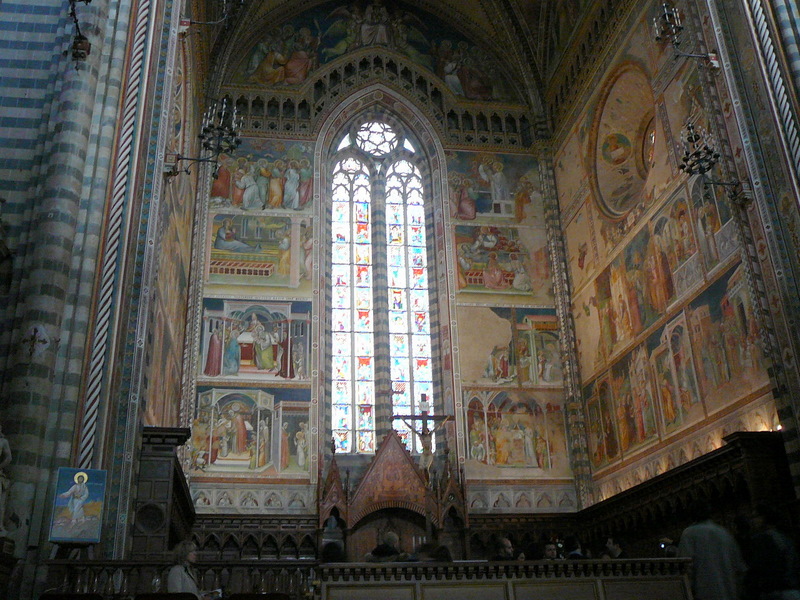
Above: the
rectangular sanctuary of the east end, transformed by
Lorenzo Maitani into the Gothic style.[10]
A decade long project ending in 1999 restored the
frescoes of Ugolini di Prete Ilario and other Sienese
artists who created these in about a decade around
1370.[248]
At that time, they comprised one of the largest
fresco cycles in Italy.
Click on the pictures below to enlarge these views of
the sanctuary and choir areas:
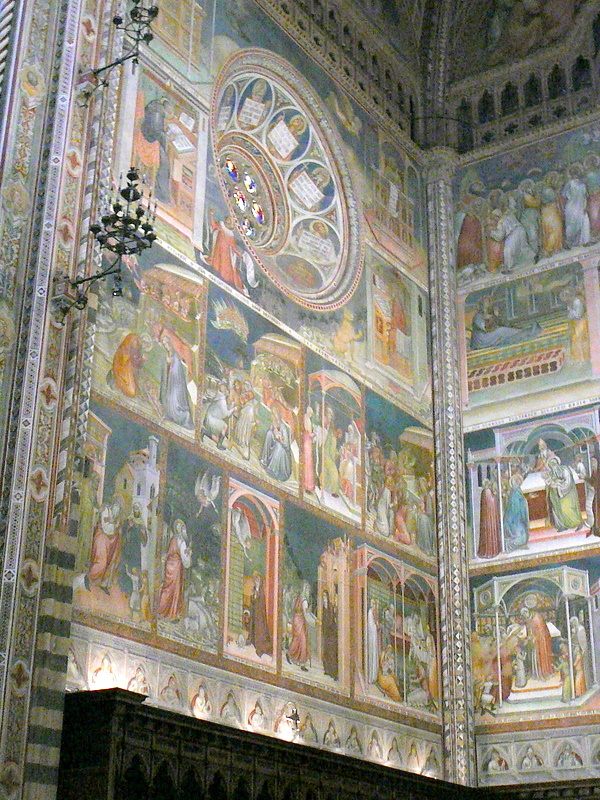
|
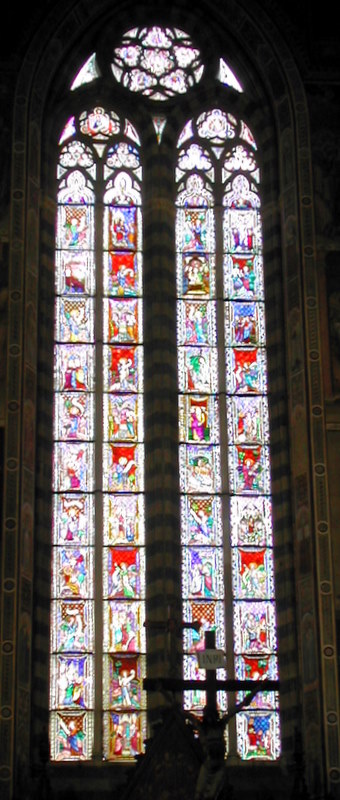
|
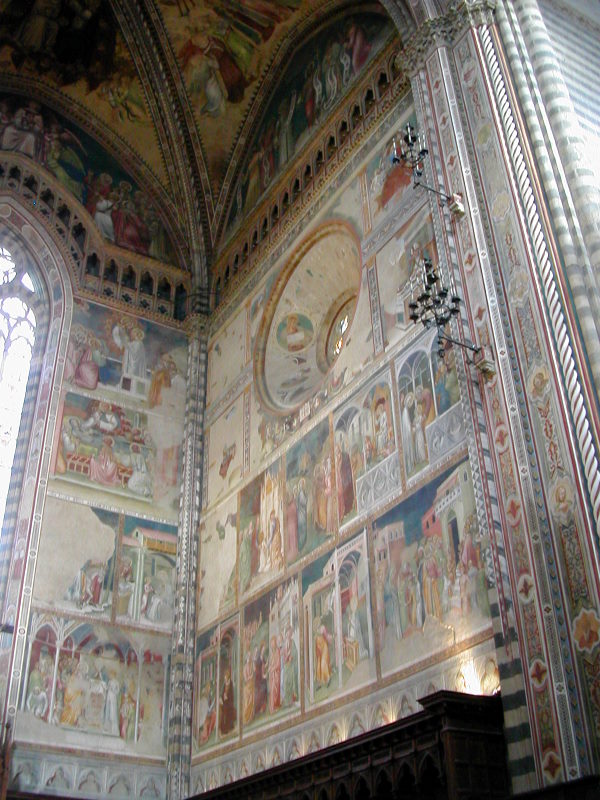
|
|
Stalls of a 14th century squarish wooden
choir, designed by either master architect Maitani
or by the Seinese Giovanni Ammanniti, surrounds the
sanctuary. |
Maitani probably designed the central window,
(1325-1334). It's about 50 feet
high... |
...and contains panels depicting episodes from the life of
Mary by members of the Orvieto
School:.[32]
Ugolino di Prete Ilario, Peter
di Puccio, and Anthony of Viterbo. |
Renaissance jewels of the left front nave
area
The left front nave area leads to the transept chapel
dedicated to the miracle of Bolsena. Two prominent
renaissance objects here are one of the largest organs
in Italy above, and the marble Pieta facing the main
altar:
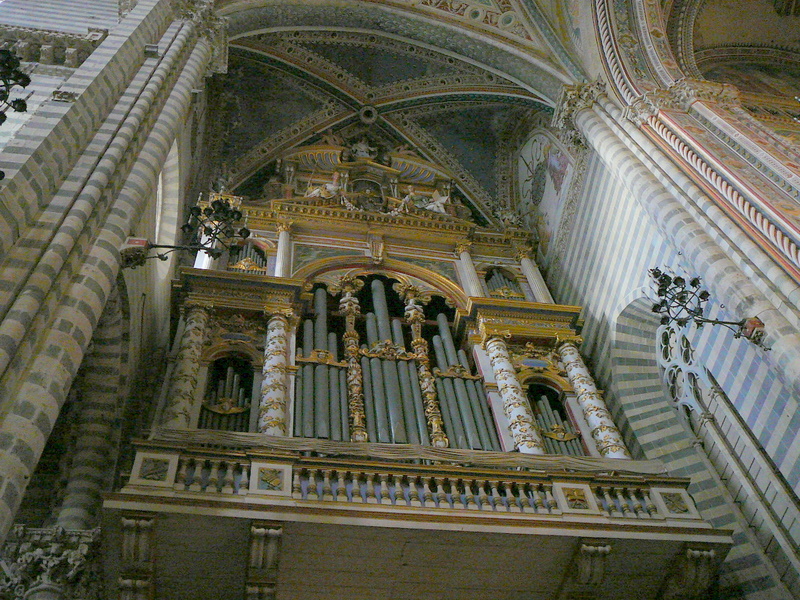
This 4000 pipe organ was first designed in
1584.[248]
Updates in 1913 and 1975 have increased its number
of pipes to 5,585.[33]
It rises above the entrance into the Cappella del
Corporale on the north side of the transept. Orvieto native Ippolito
Scalza not only designed the organ, but also
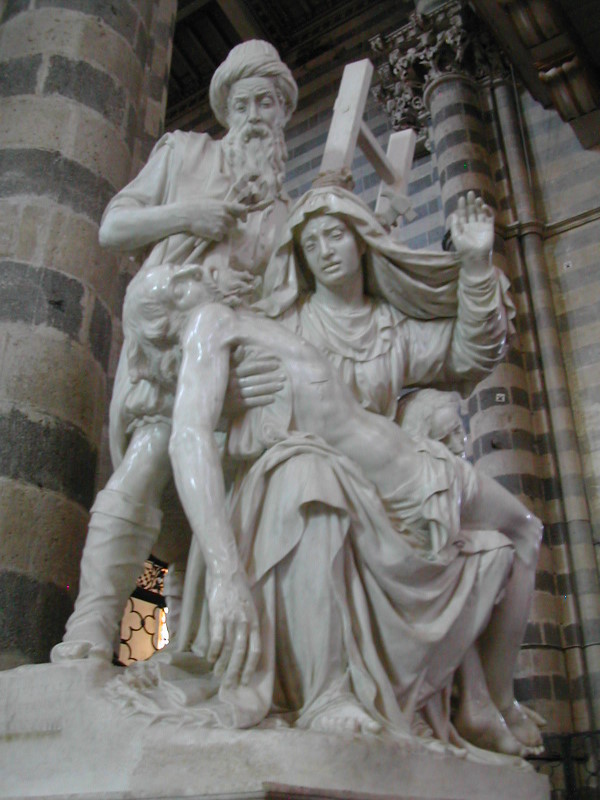 carved the four
figures on this pietą from a single block
of marble. After 9 years, he finished it in 1579.[35]
carved the four
figures on this pietą from a single block
of marble. After 9 years, he finished it in 1579.[35]
The Chapel of the Bolsena Miracle
The left (north) transept chapel, built 1328-56
,[125]
is devoted to the miracle of the cloth of Bolsena. The
cloth was the chalice-cloth (also called a
corporal), the small square
which the priest drapes over the chalice as he
begins mass. The 1263 Miracle of Bolsena
occurred when a priest doubtful about the
Transubstantiation found drops of blood on the host he was
consecrating. (
Transubstantiation is
the Catholic doctrine that during mass the bread and
wine change into the
actual body and blood of Christ even though the
physical appearances do not change). The doubting
Thomas (his name was really Peter and he was a Bohemian
priest from Prague) became a believer and the pope thought
nearby Orvieto should get a cathedral to commemorate the
miracle. (Bolsena was on a volcanic lake about 12 miles
away).
The
Miracle is supported by little historical evidence. Furthermore, it would have occurred during the lifetime
of Pope Urban IV who established the Feast of Corpus
Christi in 1264 -- but failed to reference this "smoking gun"
in the Bull that established that feast day to honor the
mystery of the Eucharist. No matter -- the chapel and
reliquary left behind celebrate the miracle of Bolsena and
the Euracharist in general using lavish fresco and
enamel. Paint and plaster don't doubt.
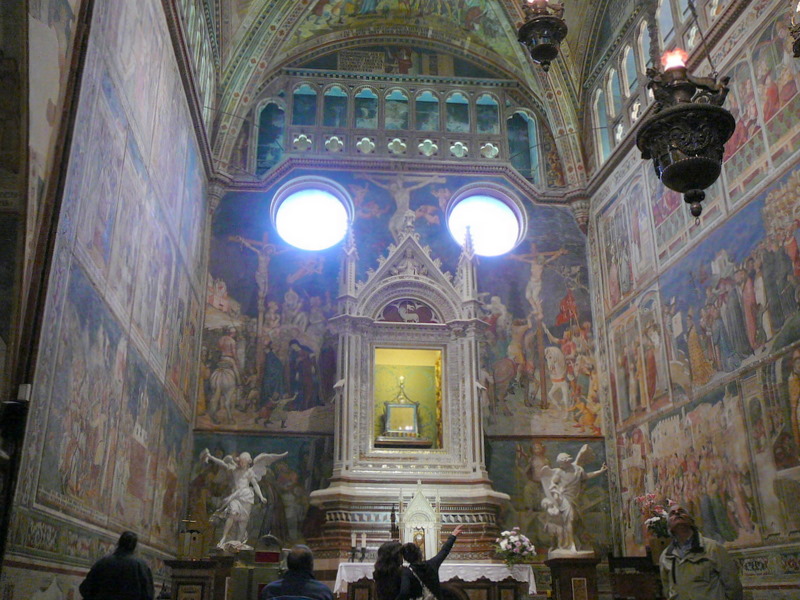
Above: Frescoes occupy just about every inch of wall space
as seen in this central view of the crucifixion scene.
Painted 1357-1363, they are primarily the works of
three Orvietan artists: Ugolini di Prete Ilario, Domenico
di Meo, and Giovanni di Buccio Leonardelli
.[48]
The 1358 aedicula-shaped
tabernacle was designed by Nicola da Siena[248]
but finished by the
Duomo's then-capomaestro who created the rose window:
Andrea Orcagna.[33]
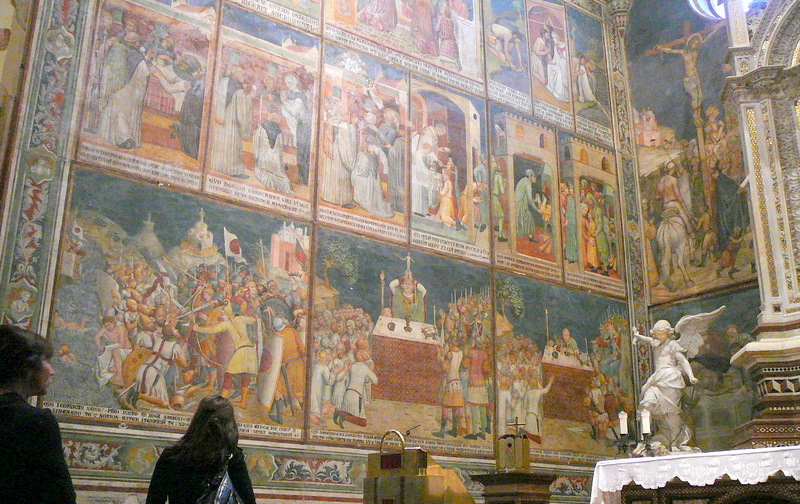
Above: the left side of the Chapel of the Corporal showing
a graphic novel (note the textual narrative) relating the
history of the Eucharist. Note the lower left hand
corner called "The Conversion of the Saracens."
Nothing like an arrow to remove all religious doubt!
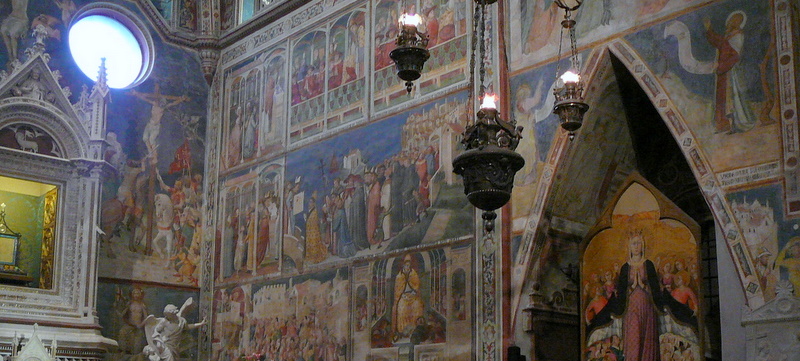
Above: the right side of the Chapel of the Corporal shows
scenes relating to the Miracle of Bolsena, a town near
Orvieto. These include Pope Urban IV who heard of the
miracle while living in Orvieto and asked that the cloth be
brought to him. He directed Thomas of Aquinas to
compose a mass for the Feast of Corpus Christi
.[124]
The scenes on this side lack the text on the frescoes of
the left side. The niche contains ...
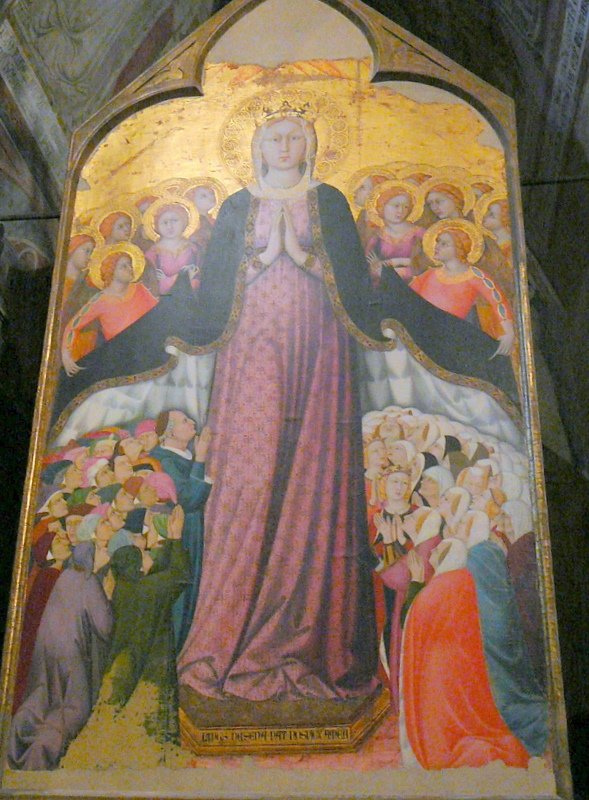
..this 1339 Madonna of the Recommended by the Sienese
Lippo
Memmi, in the Italian
Byzantine tradition. The Gothic came
late to Italy and it was heavily influenced by the
classical and Byzantine traditions which were stronger here
than in northern Europe, given this area's heritage and
location.
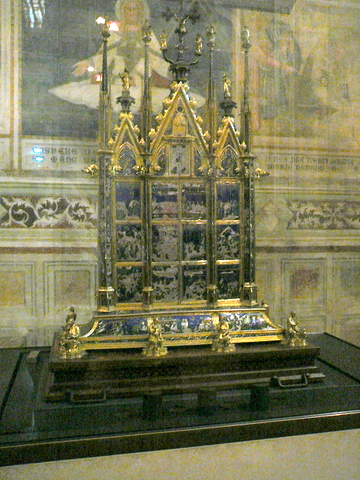 The Reliquary
The Reliquary
Below is the large (4.5 foot tall) reliquary which contains
the chalice cloth (corporal) of the miracle of
Bolsena. Brackets on the base allow this large enameled
icon to be carried in processions on the feast of Corpus
Christi. (
Click here to see such a procession).
It is the 1337 silver handiwork of
the Sienese goldsmith Ugolino di Męstro
Vieri.
Its shape suggests the Duomo facade with its triple
gables summit. The enameled scenes depict the
Passion of Christ and the Miracle of Bolsena.
The cloth inside contains red drops (of blood, believers
say) that roughly resemble a traditional
profile of Jesus.
Not the last Last Judgment
Financed by the Monaldeschi, a weathy Orvietan clan,
[249]
the south transept chapel was completed later
(1408-1444)
[125]
and is thus called the new chapel (Capella Nuova). It
featured relics from local saints and after the icon
of the Madonna of San Brizio was placed here, it
became known as the Chapel of San Brizio. Visitors
approach through a a large iron gate.
Any
discussion of this magnificent cathedral must pay tribute
to the even more magnificent Last Judgment frescoes in this
chapel by the Renaissance master Luca d'Egidio
di Ventura de' Signorelli. But long
before Signorelli, there was Angelico. Wishing to decorate
this area with frescoes in order to attract visitors and
help Orvieto recover its once important position, the
cathedral works committee engaged the well-known
early Italian
Renaissance painter Fra Angelico to fresco this chapel's
vaults, starting in 1447.
But under pressure to
begin work at the Vatican, this Dominican reneged on his
contract before completing work on even the first three
segments. With his pupil Benozzo Gozzoli, Angelico had painted
images featuring Christ, Mary, and the Apostles; but for a
half century, these remained unfinished.[71]
After a search, Luca Signorelli,was at first tasked with
completing Fra Angelico's frescoes. Impressed with his
skill and speed, the cathedral board of works let him finish the chapel vault and sides,
creating a masterpiece and what was then probably the
greatest Last Judgment fresco. That judgment would,
of course, not last. An upstart named Michelangelo
visited Orvieto, saw its frescoes, and was not
uninfluenced. Threedecades later he created
his Last Judgment
in the Sistine Chapel. When
Michelangelo was still 8 years old, Signorelli himself was
painting frescoes in the Sistine Chapel, 15
years before starting
his masterpiece here in Orvieto. It was a
small world, but one well frescoed.
Despite an admission charge, photos are verboten here.
Below are a few public domain photos of Signorelli's
Dante-inspired masterpiece courtesy of Wikipedia:
(Click on any of these thumbnails to see
these frescoes full screen size)
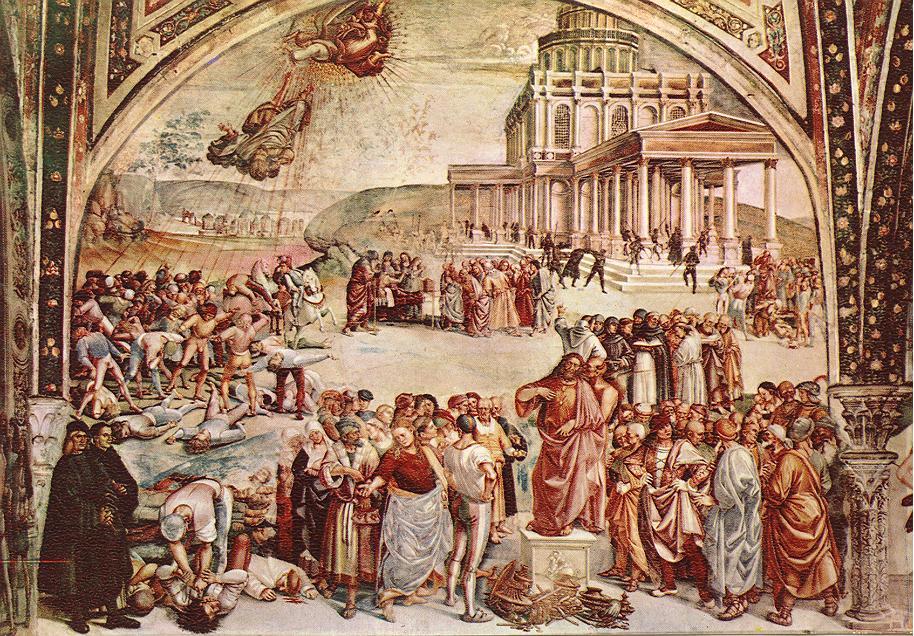
|

|
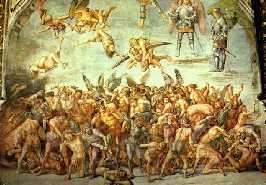
|
| Signorelli's
Antichrist preaching with the Devil at his side in
front of the Temple of Solomon.. At lower left,
the two bystanders in black are thought to represent
the two artists: Fra Angelico and
Signorelli. |
Signorelli's Resurrection featuring his
trademark nude figures. What he lacked in
color, he made up for in anatomy. Michaelangelo was
obviously impressed.. |
Signorelli's scenes from hell allow for all manner of
twisted bodies. At center the devil absconds a women,
suggesting some of Zeus's classical
abductions. |
The Nave west end
Decades before Fra Angelico started his frescoes in the
Capella Nuova, his more famous contemporary Gentile da
Fabriano created this
International Gothic Madonna and child
gracing the south aisle just before the west entrance.
Despite its art and the reputation of its artist, we
are lucky to have what's left of this fresco, given the 7
centuries of vicissitudes these walls have endured.
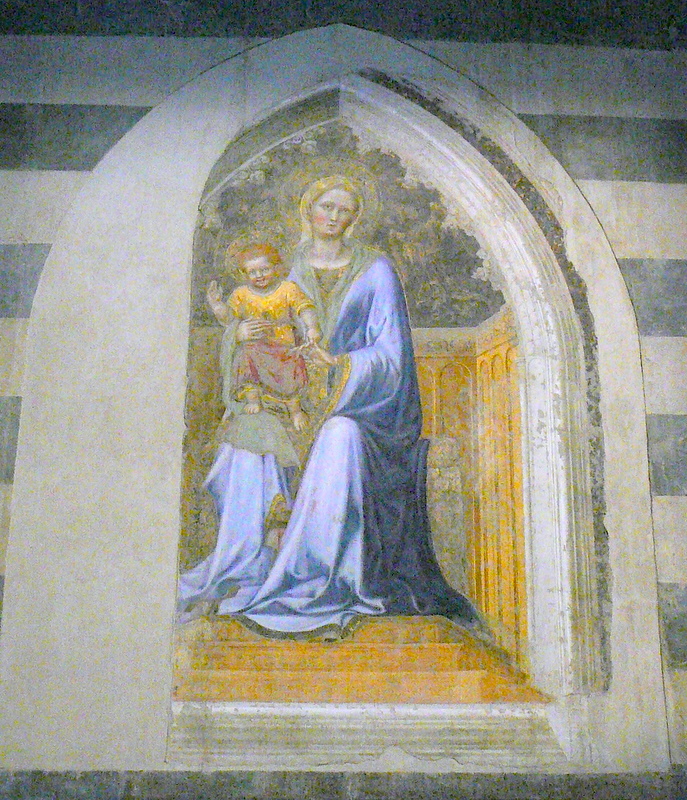
Above:
a 1425 damaged fresco by Gentile da Fabriano; the tall and graceful
Mary is typical of International Gothic and this is a Maestą, an
iconic convention showing the Madonna and child on a throne. The
rounded face and soft drapery is characteristic of da Fabriano.
This makes quite a colorful contrast with the stripes
of volcanic basalt and travertine marble that give the side aisles and
nave its severe look.
Today the interior of the gray-and-white striped nave is
relatively uncluttered, making the explosion of color of
the chapel and apse frescoes even more dramatic.
However, this was not always the case. In the
first century of this Duomo's long existence, its town was
in decline
[542] from plague, politics
-- and a papacy that had moved to Avignon in France rather
than making Orvieto its second home as the city fathers
once thought would be the case. About all the noble
families of the town had was the cathedral -- and they
proceeded to layer fresco upon fresco in the nave touting
their importance, a bit like handbills pasted on vacant
walls in busy cities.
A plethora of popes
In the meantime, the papacy had moved back to Italy after
eliminating an anti-pope named John XXIII -- did you
piously think you knew who
John XXIII was? You have a right to be
confused, there were, in fact, three popes simultaneously
when the election of
Martin V ended the
Western Schism. Martin visited Orvieto
in 1420 in his attempt to revive the Papal states. He
did revive the Duomo board of works which, in turn, began
clamping down on the cathedral's fresco pollution.
Hoping good art would drive out bad. the board also
invited the two most prominent artists of the early 15th
century to create significant works for the nave. These two
were Donatello who was to create a statue for the Baptismal
font (he probably never did), and Gentile da
Fabriano who created the frescoed
Maestą shown above
.[542] Famous or not,
little of Fabriano's work has survived the ages.
Later Duomo Boards cleaned up most of the other
frescos on the nave and side aisle walls and appear to have
spared Fabriano's only because it had a devoted religious
following -- not for its artistic value.
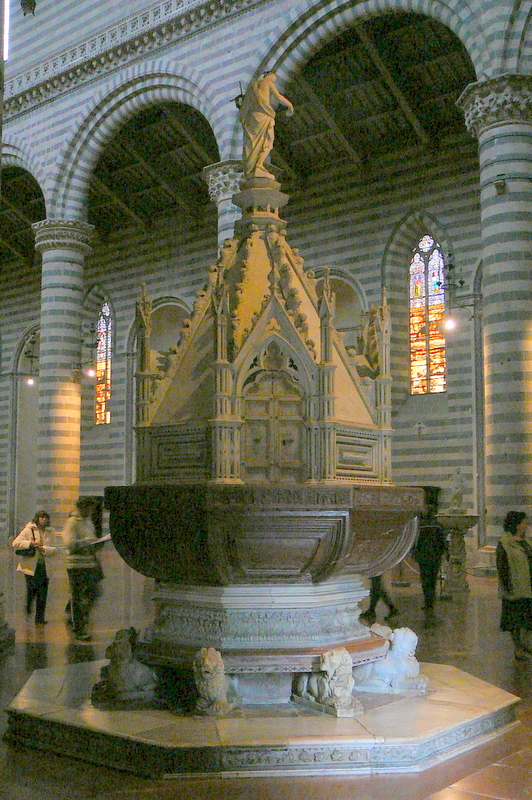 Right: This baptismal
font with its lions and elaborate frieze reliefs was carved
by Luca di Giovanni for 16 years, completing in
1406.[33] Many other artists have augmented
Luca's work.
Right: This baptismal
font with its lions and elaborate frieze reliefs was carved
by Luca di Giovanni for 16 years, completing in
1406.[33] Many other artists have augmented
Luca's work.
The large
arcade as seen here is characteristic of the
larger 13th century Italian Gothic churches.
Below is a photo taken of the right (south) aisle at the
17th century pulpit by G. Mercanti.[81]
At
the left is the grilled gate leading to the Renaissance masterpiece of
the Cappella Nuova (Chapel of Saint Brizio). To the right is one
of the aisle chapels -- one of ten tall half cylinders, some of
which, as seen here, still containing their lovely Byzantine-inspired
high decoration. While this wooden pulpit is impressive, the
pulpit itself is a poor rival to the Nicola Pisano's stone masterpieces
found in other great central Italian cathedrals such as at Pisa
or Sienna in the 13th century.
Most of these ten chapels were decorated by the
late-Renaissance master Girolamo
Muziano and his pupil
Cesare Nebbia in the last half of the 16th
century. Muziano began the work in his early twenties
and continued even though he was became the most prominent
artist in Rome around 1570. For the most part, their
work did not survive the 19th century "clean-up" of
frescoes on the wall. Only some of their altarpieces
can now be seen across the street from the Duomo in the
Cathedral museum
.[410]
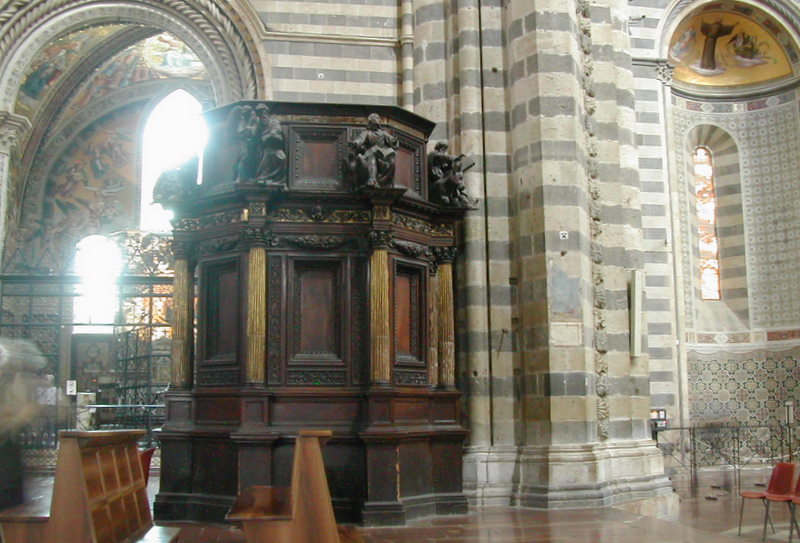
Above: G. Mercanti's 17th century wooden pulpit
To see a description of this cathedral's magnificent
facade, one of the mosts significant Italian Gothic
exterior works,
click
here.
Return to our Orvieto index by
clicking here:




 carved the four
figures on this pietą from a single block
of marble. After 9 years, he finished it in 1579.[35]
carved the four
figures on this pietą from a single block
of marble. After 9 years, he finished it in 1579.[35]





